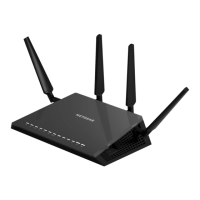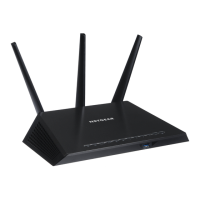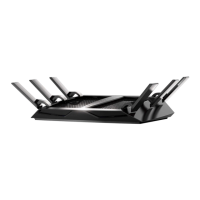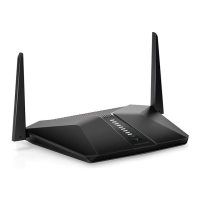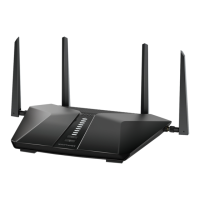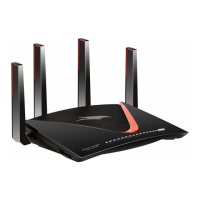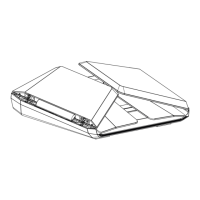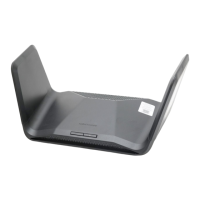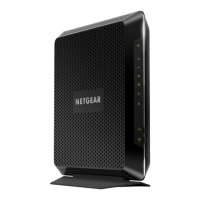Do you have a question about the NETGEAR Nighthawk AC2400 and is the answer not in the manual?
Details the items included in the router's packaging, listing the router, antennas, Ethernet cable, and power adapter.
Provides instructions on how to attach the router's three antennas for best WiFi performance, recommending specific angles.
Explains the status LEDs and buttons on the top panel of the router, detailing their functions and indicator lights.
Describes the ports, buttons, and connectors located on the back panel of the router, including Reset, Ethernet LAN, and WAN ports.
Identifies the USB 3.0 port located on the front panel of the router for connecting external devices.
Explains where to find essential router information like login details, WiFi SSID, and MAC address on the router's label.
Offers guidelines for positioning the router to maximize WiFi range and signal strength, avoiding interference.
Illustrates the process of cabling the router, connecting it to the modem and power, to establish Internet access.
Guides on connecting to the router via Ethernet cable or WiFi, including steps for finding and joining the network.
Differentiates between ISP login, WiFi password, and router login for accessing network services and settings.
Details how to use the Nighthawk mobile app for router installation, personalization, and registration with NETGEAR.
Instructions for accessing the router's web interface using a browser to view or change settings.
Explains how to change the default language setting of the router's web interface to a preferred language.
Guides users through the Setup Wizard to automatically detect and configure Internet settings for the router.
Provides steps to manually set up the router's Internet connection, including options for connections with or without a login.
Explains how to set up various IPv6 Internet connection types, including Auto Detect, Auto Config, 6to4 Tunnel, and PPPoE.
Discusses MTU concepts and provides instructions on how to change the MTU size for optimal Internet communication.
Details how to use access control to permit or deny network access for specific devices based on MAC addresses.
Explains how to block specific websites by entering keywords or domain names on a permanent or scheduled basis.
Guides on blocking specific Internet services or applications, either always or based on a schedule.
Covers managing lists of allowed or blocked devices, including viewing and editing entries within access control settings.
Details how to set up a schedule to block Internet sites and services based on specific days and times.
Explains how to set up email notifications for router activity and security events, including log alerts.
Describes how to view and configure Wide Area Network (WAN) settings, including DoS protection and MTU size.
Explains how to configure a default DMZ server to improve compatibility with certain online applications, noting security risks.
Guides on changing the router's device name, which is displayed in the file manager when browsing the network.
Details how to change the router's Local Area Network (LAN) IP address and subnet mask settings.
Explains how to configure the range of IP addresses the router assigns via DHCP to connected LAN devices.
Provides instructions on how to disable the router's built-in DHCP server feature if another device handles IP assignment.
Explains how to assign permanent IP addresses to specific computers or servers on the LAN using IP address reservation.
Details how to use the WPS Wizard to easily add WPS-enabled devices to the WiFi network without a password.
Guides on setting up basic WiFi parameters like network name (SSID), security, and region for optimal wireless performance.
Explains how to change the WiFi Mbps settings to optimize data rates for high-speed transmissions on both 2.4 GHz and 5 GHz bands.
Provides steps to change the WiFi password (network key) and select WiFi security options like WPA2-PSK [AES].
Guides on enabling and configuring a separate guest WiFi network for visitors, with options for security and SSID customization.
Explains how to enable or disable the router's WiFi radios using the physical button or through the web interface.
Details how to set up a schedule to automatically turn off the WiFi signal during specific times or days.
Guides on specifying WPS settings, including enabling the router's PIN and managing existing wireless settings.
Instructions on setting up the router to function as a WiFi Access Point (AP) on an existing local network.
Explains how to configure the router in bridge mode to connect devices wirelessly at faster 802.11ac speeds.
Guides on setting up bridges for port groups or VLAN tag groups, often required for IPTV or specific ISP services.
Explains how to add static routes for advanced network configurations, typically involving multiple routers or subnets.
Details how to enable and configure QoS to prioritize Internet streaming, applications, and services for better performance.
Explains Wi-Fi Multimedia QoS, which prioritizes WiFi voice and video traffic, and how to disable it if necessary.
Guides on enabling Universal Plug-N-Play (UPnP) to help devices discover and connect to network services automatically.
Provides instructions on checking for and updating the router's firmware to the latest version for new features and bug fixes.
Guides on manually uploading a specific firmware version to the router, especially if automatic updates fail.
Details how to change the router's admin password for security and enable password recovery options.
Explains the process of recovering the router's admin password using security questions if it has been forgotten.
Guides on viewing router information, Internet port status, and WiFi settings, including color-coded status indicators.
Explains how to display detailed statistics for the router's Internet and LAN ports, including traffic and link status.
Guides on checking the router's Internet connection status, IP address, subnet mask, and DHCP/DNS server information.
Details how to view, manage, clear, and email router activity logs, which record website access and actions.
Explains how to monitor Internet traffic volume and set traffic limits using the router's traffic meter feature.
Guides on backing up, erasing, and restoring the router's configuration settings and files.
Details how to set up and use remote management to access and change router settings over the Internet.
Provides options to disable LED blinking for network activity or turn off all LEDs except the power LED.
Explains how to reset the router to its original factory default settings using the reset button or erase function.
Guides on installing the necessary printer driver software and connecting the USB printer to the router.
Provides a link and steps to download the ReadySHARE Printer utility for Windows-based and Mac computers.
Details the installation process for the ReadySHARE Printer utility, which installs the NETGEAR USB Control Center.
Explains how to print documents using the NETGEAR USB Control Center, managing print jobs and queues.
Guides on viewing the status of connected USB printers and changing their availability for network sharing.
Explains how to use the scanning feature of a multifunction USB printer connected to the router.
Details how to customize settings for the NETGEAR USB Control Center, including disabling auto-startup and changing language.
Explains how to set up a Dynamic DNS service to access your home network remotely using a domain name.
Guides on enabling FTP access through the Internet to share files on USB storage devices connected to the router.
Details on setting up a personal FTP server using a customized URL and Dynamic DNS for remote network access.
Provides steps to register for a free NETGEAR Dynamic DNS account for remote access to your network.
Guides on configuring the router to use an already created Dynamic DNS account with providers like NETGEAR, No-IP, or Dyn.
Explains how to modify existing Dynamic DNS account settings as needed for remote network access.
Guides on accessing USB storage devices through the Internet, using either Dynamic DNS or the router's IP address.
Details on using the NETGEAR ReadyCLOUD service to remotely access files stored on a router-connected USB device.
Provides steps to create a NETGEAR ReadyCLOUD account for remote access to USB storage devices.
Guides on registering your router with your ReadyCLOUD account to enable remote access to connected USB storage.
Guides on configuring the router as a DLNA/UPnP AV-compliant media server for viewing media on compatible players.
Details how to set up the router's iTunes server to play music from a USB device using iTunes and Home Sharing.
Explains how to use the Apple Remote app on iPhone/iPad to play music from a router-connected USB device.
Guides on setting up the router to allow TiVo devices to access media files stored on a connected USB device.
Provides instructions on changing the router's NTP server to sync network time with a preferred server.
Lists requirements for USB storage devices, including supported file systems and compatibility notes.
Provides instructions on physically connecting a USB storage device to the router's USB port.
Guides on accessing USB storage devices connected to the router from a Windows-based computer.
Explains how to map a USB storage device to a network drive in Windows for easier access.
Guides on accessing USB storage devices connected to the router from a Mac computer using Connect to Server.
Details how to use the ReadySHARE Vault software for automatic backups of Windows-based computers to USB storage.
Explains how to use Time Machine to back up Mac computers to a USB hard drive connected to the router.
Guides on formatting a USB hard drive and specifying partitions for use with Mac Time Machine backups.
Provides recommendations for preparing a Mac computer for large data backups using Time Machine.
Details the process of performing Mac backups onto a USB hard disk drive connected to the router using Time Machine.
Guides on enabling FTP access within the local network for faster file downloads and uploads.
Explains how to view and change network folder settings, including share names and access permissions.
Provides steps to add network folders on a USB storage device connected to the router's USB port.
Guides on editing existing network folder settings on a USB storage device connected to the router.
Details the procedure for safely removing a USB storage device from the router to prevent data loss.
Guides on setting up port forwarding rules to allow specific incoming traffic to reach a local server.
Explains how to add custom port forwarding rules for applications not listed in the default services.
Guides on editing existing port forwarding service entries to modify rules and settings.
Provides instructions on removing a port forwarding entry from the router configuration.
Explains how the router implements port forwarding rules, showing the sequence of traffic flow.
Guides on adding port triggering services to dynamically open ports for specific applications.
Details how to enable port triggering and configure timeout settings for managing inbound traffic.
Offers general tips for troubleshooting common router and network issues, including restarting sequences.
Guides on diagnosing router problems by observing the status and behavior of the router's LEDs.
Provides solutions for issues preventing users from logging into the router's web interface.
Guides on diagnosing and resolving problems where the router has an IP address but no Internet access.
Offers solutions for issues preventing computers from loading web pages, even with Internet connectivity.
Provides steps to ensure router configuration changes are saved correctly, including using the Apply and Refresh buttons.
Guides on isolating and resolving problems with connecting to the router's WiFi network.
Explains how to use the ping utility to test network connectivity and diagnose path issues to the router or remote devices.
Details the default factory settings for the router, including login, Internet, LAN, and security configurations.
Provides a comprehensive list of the router's technical specifications, including protocols, power, dimensions, and WiFi standards.
Details the items included in the router's packaging, listing the router, antennas, Ethernet cable, and power adapter.
Provides instructions on how to attach the router's three antennas for best WiFi performance, recommending specific angles.
Explains the status LEDs and buttons on the top panel of the router, detailing their functions and indicator lights.
Describes the ports, buttons, and connectors located on the back panel of the router, including Reset, Ethernet LAN, and WAN ports.
Identifies the USB 3.0 port located on the front panel of the router for connecting external devices.
Explains where to find essential router information like login details, WiFi SSID, and MAC address on the router's label.
Offers guidelines for positioning the router to maximize WiFi range and signal strength, avoiding interference.
Illustrates the process of cabling the router, connecting it to the modem and power, to establish Internet access.
Guides on connecting to the router via Ethernet cable or WiFi, including steps for finding and joining the network.
Differentiates between ISP login, WiFi password, and router login for accessing network services and settings.
Details how to use the Nighthawk mobile app for router installation, personalization, and registration with NETGEAR.
Instructions for accessing the router's web interface using a browser to view or change settings.
Explains how to change the default language setting of the router's web interface to a preferred language.
Guides users through the Setup Wizard to automatically detect and configure Internet settings for the router.
Provides steps to manually set up the router's Internet connection, including options for connections with or without a login.
Explains how to set up various IPv6 Internet connection types, including Auto Detect, Auto Config, 6to4 Tunnel, and PPPoE.
Discusses MTU concepts and provides instructions on how to change the MTU size for optimal Internet communication.
Details how to use access control to permit or deny network access for specific devices based on MAC addresses.
Explains how to block specific websites by entering keywords or domain names on a permanent or scheduled basis.
Guides on blocking specific Internet services or applications, either always or based on a schedule.
Covers managing lists of allowed or blocked devices, including viewing and editing entries within access control settings.
Details how to set up a schedule to block Internet sites and services based on specific days and times.
Explains how to set up email notifications for router activity and security events, including log alerts.
Describes how to view and configure Wide Area Network (WAN) settings, including DoS protection and MTU size.
Explains how to configure a default DMZ server to improve compatibility with certain online applications, noting security risks.
Guides on changing the router's device name, which is displayed in the file manager when browsing the network.
Details how to change the router's Local Area Network (LAN) IP address and subnet mask settings.
Explains how to configure the range of IP addresses the router assigns via DHCP to connected LAN devices.
Provides instructions on how to disable the router's built-in DHCP server feature if another device handles IP assignment.
Explains how to assign permanent IP addresses to specific computers or servers on the LAN using IP address reservation.
Details how to use the WPS Wizard to easily add WPS-enabled devices to the WiFi network without a password.
Guides on setting up basic WiFi parameters like network name (SSID), security, and region for optimal wireless performance.
Explains how to change the WiFi Mbps settings to optimize data rates for high-speed transmissions on both 2.4 GHz and 5 GHz bands.
Provides steps to change the WiFi password (network key) and select WiFi security options like WPA2-PSK [AES].
Guides on enabling and configuring a separate guest WiFi network for visitors, with options for security and SSID customization.
Explains how to enable or disable the router's WiFi radios using the physical button or through the web interface.
Details how to set up a schedule to automatically turn off the WiFi signal during specific times or days.
Guides on specifying WPS settings, including enabling the router's PIN and managing existing wireless settings.
Instructions on setting up the router to function as a WiFi Access Point (AP) on an existing local network.
Explains how to configure the router in bridge mode to connect devices wirelessly at faster 802.11ac speeds.
Guides on setting up bridges for port groups or VLAN tag groups, often required for IPTV or specific ISP services.
Explains how to add static routes for advanced network configurations, typically involving multiple routers or subnets.
Details how to enable and configure QoS to prioritize Internet streaming, applications, and services for better performance.
Explains Wi-Fi Multimedia QoS, which prioritizes WiFi voice and video traffic, and how to disable it if necessary.
Guides on enabling Universal Plug-N-Play (UPnP) to help devices discover and connect to network services automatically.
Provides instructions on checking for and updating the router's firmware to the latest version for new features and bug fixes.
Guides on manually uploading a specific firmware version to the router, especially if automatic updates fail.
Details how to change the router's admin password for security and enable password recovery options.
Explains the process of recovering the router's admin password using security questions if it has been forgotten.
Guides on viewing router information, Internet port status, and WiFi settings, including color-coded status indicators.
Explains how to display detailed statistics for the router's Internet and LAN ports, including traffic and link status.
Guides on checking the router's Internet connection status, IP address, subnet mask, and DHCP/DNS server information.
Details how to view, manage, clear, and email router activity logs, which record website access and actions.
Explains how to monitor Internet traffic volume and set traffic limits using the router's traffic meter feature.
Guides on backing up, erasing, and restoring the router's configuration settings and files.
Details how to set up and use remote management to access and change router settings over the Internet.
Provides options to disable LED blinking for network activity or turn off all LEDs except the power LED.
Explains how to reset the router to its original factory default settings using the reset button or erase function.
Guides on installing the necessary printer driver software and connecting the USB printer to the router.
Provides a link and steps to download the ReadySHARE Printer utility for Windows-based and Mac computers.
Details the installation process for the ReadySHARE Printer utility, which installs the NETGEAR USB Control Center.
Explains how to print documents using the NETGEAR USB Control Center, managing print jobs and queues.
Guides on viewing the status of connected USB printers and changing their availability for network sharing.
Explains how to use the scanning feature of a multifunction USB printer connected to the router.
Details how to customize settings for the NETGEAR USB Control Center, including disabling auto-startup and changing language.
Explains how to set up a Dynamic DNS service to access your home network remotely using a domain name.
Guides on enabling FTP access through the Internet to share files on USB storage devices connected to the router.
Details on setting up a personal FTP server using a customized URL and Dynamic DNS for remote network access.
Provides steps to register for a free NETGEAR Dynamic DNS account for remote access to your network.
Guides on configuring the router to use an already created Dynamic DNS account with providers like NETGEAR, No-IP, or Dyn.
Explains how to modify existing Dynamic DNS account settings as needed for remote network access.
Guides on accessing USB storage devices through the Internet, using either Dynamic DNS or the router's IP address.
Details on using the NETGEAR ReadyCLOUD service to remotely access files stored on a router-connected USB device.
Provides steps to create a NETGEAR ReadyCLOUD account for remote access to USB storage devices.
Guides on registering your router with your ReadyCLOUD account to enable remote access to connected USB storage.
Guides on configuring the router as a DLNA/UPnP AV-compliant media server for viewing media on compatible players.
Details how to set up the router's iTunes server to play music from a USB device using iTunes and Home Sharing.
Explains how to use the Apple Remote app on iPhone/iPad to play music from a router-connected USB device.
Guides on setting up the router to allow TiVo devices to access media files stored on a connected USB device.
Provides instructions on changing the router's NTP server to sync network time with a preferred server.
Lists requirements for USB storage devices, including supported file systems and compatibility notes.
Provides instructions on physically connecting a USB storage device to the router's USB port.
Guides on accessing USB storage devices connected to the router from a Windows-based computer.
Explains how to map a USB storage device to a network drive in Windows for easier access.
Guides on accessing USB storage devices connected to the router from a Mac computer using Connect to Server.
Details how to use the ReadySHARE Vault software for automatic backups of Windows-based computers to USB storage.
Explains how to use Time Machine to back up Mac computers to a USB hard drive connected to the router.
Guides on formatting a USB hard drive and specifying partitions for use with Mac Time Machine backups.
Provides recommendations for preparing a Mac computer for large data backups using Time Machine.
Details the process of performing Mac backups onto a USB hard disk drive connected to the router using Time Machine.
Guides on enabling FTP access within the local network for faster file downloads and uploads.
Explains how to view and change network folder settings, including share names and access permissions.
Provides steps to add network folders on a USB storage device connected to the router's USB port.
Guides on editing existing network folder settings on a USB storage device connected to the router.
Details the procedure for safely removing a USB storage device from the router to prevent data loss.
Guides on setting up port forwarding rules to allow specific incoming traffic to reach a local server.
Explains how to add custom port forwarding rules for applications not listed in the default services.
Guides on editing existing port forwarding service entries to modify rules and settings.
Provides instructions on removing a port forwarding entry from the router configuration.
Explains how the router implements port forwarding rules, showing the sequence of traffic flow.
Guides on adding port triggering services to dynamically open ports for specific applications.
Details how to enable port triggering and configure timeout settings for managing inbound traffic.
Offers general tips for troubleshooting common router and network issues, including restarting sequences.
Guides on diagnosing router problems by observing the status and behavior of the router's LEDs.
Provides solutions for issues preventing users from logging into the router's web interface.
Guides on diagnosing and resolving problems where the router has an IP address but no Internet access.
Offers solutions for issues preventing computers from loading web pages, even with Internet connectivity.
Provides steps to ensure router configuration changes are saved correctly, including using the Apply and Refresh buttons.
Guides on isolating and resolving problems with connecting to the router's WiFi network.
Explains how to use the ping utility to test network connectivity and diagnose path issues to the router or remote devices.
Details the default factory settings for the router, including login, Internet, LAN, and security configurations.
Provides a comprehensive list of the router's technical specifications, including protocols, power, dimensions, and WiFi standards.
| Wi-Fi Standard | 802.11ac |
|---|---|
| Maximum Wi-Fi Speed | 2400 Mbps |
| Wi-Fi Performance | AC2400 |
| USB Ports | 2 x USB 3.0 |
| Beamforming | Yes |
| MU-MIMO | Yes |
| Beamforming+ | Yes |
| VPN Support | Yes |
| Guest Network | Yes |
| Parental Controls | Yes |
| Quality of Service (QoS) | Yes |
| Model | AC2400 |
| Frequency Bands | 2.4 GHz and 5 GHz |
| Ethernet Ports | 4 |
| Processor | Dual-core 1 GHz |
| Security | WPA2, WPA |
| Memory | 128 MB Flash, 256 MB RAM |
